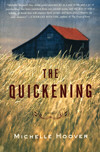The Quickening
In a brief, illuminating YouTube interview on the publisher’s website, Michelle Hoover discusses the genesis of The Quickening. She discovered a typewritten memoir, composed in 1950, by her great grandmother about her experiences as a farmer and farm wife. The memoir of twenty or more pages covers much of this strong woman’s life in the first half of the Twentieth Century. Hoover used this story and further research on family history and U.S. farm life as a springboard to create the imaginative world of this novel.
In a brief, illuminating YouTube interview on the publisher’s website, Michelle Hoover discusses the genesis of The Quickening. She discovered a typewritten memoir, composed in 1950, by her great grandmother about her experiences as a farmer and farm wife. The memoir of twenty or more pages covers much of this strong woman’s life in the first half of the Twentieth Century. Hoover used this story and further research on family history and U.S. farm life as a springboard to create the imaginative world of this novel.
The Quickening is narrated by two women in alternating chapters. Enidina is tall, big-boned, hefty, outwardly often gruff but possessing an underlying sensitivity, and happily married to Frank Current. They live on their Midwestern farm a half-mile from the Morrow family – no state is named, though Hoover’s relatives resided mostly in Iowa and Missouri. Mary Morrow, traumatized by rape at age 12, manipulative, self-justifying, befriends Enidina, and the book takes us through several decades and the many vicissitudes of their interwoven lives. There are droughts, torrential rains, fires, a meteor crashing to earth, vivid scenes of hog-slaughtering, the births and deaths of animals and humans, the press of events from the First World War and the Depression, reversals and betrayals. Religion plays a major role; there are immersion baptisms, enigmatic sermons, and Mary’s relationship with a lonely minister named Borden.
Feelings of loneliness and longing often drive the two main characters. As Mary says early on in the story,
When I looked in the window again, I caught my breath – the afternoon had darkened, my reflection suddenly bone-thin, and I feared everything in me that had been bright and young could die in this place before I ever turned thirty.
Later, Enidina says, “I’ve seen it. Loneliness can make you do terrible things.” Hoover creates a stark landscape in which the characters are isolated by the demands of daily survival – canning, milking cows, plowing, harvesting – and also trapped by bad weather in the claustrophobic interiors of their houses, without autos or phones or central heat. Visitors arrive mostly on foot or in buggies.
I’m sympathetic with Hoover’s attempts to portray this kind of life – its demands for hard physical work, its isolating quality, the possibilities of psychological and spiritual suffering that can result; she wants to put us in a world that has passed, yet is vitally important to remember and re-imagine. However, I don’t think the book fully convinces. Perhaps it’s a matter of pitch. The intensity of the events, the depth of the betrayals, the sheer number of traumas brought on, for me, a feeling of “Yikes, what next?”
The book weaves in elemental motifs of blood, fire, sexual awakening, the quickenings of pregnancy, but there’s a certain schematic quality that kept me at a distance from the characters, even when someone was beating animals to death with a club or setting fire to a child’s corpse in a field. There are too many such events, and the book often becomes melodramatic. Hoover’s relative’s memoir, on the other hand, has a matter-of-fact tone that is often moving without being over the top. There’s a sense, even in its brevity and focus on major events, of time passing with less drama than in the novel. Its pitch seems to me more realistic than Hoover’s novel; it also makes more room for simple human decency. Of course Hoover needs juxtaposition, tension, compelling events to create a strong story, but perhaps not so many packed into 216 pages. Its brevity comes with too much symbolism and too little realism; the book is part fable, part naturalistic narrative, but not fully organic.
A sampling of reviews, some from such literary luminaries as Ted Kooser, Ursula Hegi, and Charles Baxter, indicates that my take on the book is probably a minority view. Most reviewers emphasize the strength of the novel’s tone and voices and its powerful imagining of the lives of its people, especially the women; some critics compare it to the work of Willa Cather. But Cather at her best, as in novels like O Pioneers and My Antonia, allowed her stories to develop with an appropriate balance of the mundane and the extraordinary, capturing the realistic cadences of day to day pioneer and farm life without forcing the drama, as Hoover often does. I see Hoover’s book as a worthy attempt, but ultimately an unsuccessful evocation of its time and people. Read it, perhaps, and judge for yourself.





